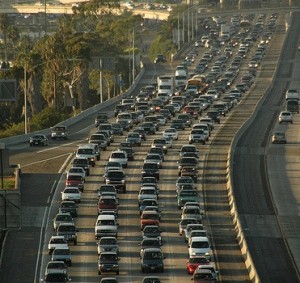Visiting Scholar, Sabin Center for Climate Change Law and Fritz B. Burns Professor of Law, Loyola Law School
In an emphatic opinion, a state appellate court has invalidated the environmental impact report for the first “sustainable communities strategy” prepared by a regional council of government in California. In Cleveland National Forest Foundation v. San Diego Association of Governments,[1] the court found that the impact report did not evaluate the plan’s consistency with an executive order setting reduction targets for greenhouse gas (GHG) emissions. The report also did not sufficiently analyze alternatives and mitigation measures. Unless the California Supreme Court hears the case, the opinion will ensure that sustainable community strategies, which integrate transportation planning with efforts to reduce GHGs, must undertake a long-range examination of how those plans will affect such reductions.
AB 32 is California’s most well-known law on climate protection. However, a second law, the Sustainable Communities and Climate Protection Act of 2008, directed the state’s Air Resources Board to develop regional GHG reduction targets for autos and light trucks by 2020 and 2035.[2] It then required regional planning agencies to adopt “sustainable communities strategies” that would meet those reduction targets. The sustainable communities strategy would be a part of each planning agency’s long-term regional transportation plan. Additionally, an Executive Order issued by former Governor Arnold Schwarzenegger required reduction of GHG emissions to 1990 levels by 2020, and to 80 percent below 1990 levels by 2050.[3]
In 2011, the San Diego Association of Governments (“Association”) produced the state’s first “sustainable communities strategy” as part of its long-range transportation plan for the region. The plan addressed freeway expansion, public transportation, and other transportation modes. The Association also prepared an environmental impact report analyzing the plan’s impacts.
The plan met the 2020 and 2035 GHG reduction targets. After those dates, however, GHG emissions from the plan turned sharply upward, but the report did not analyze the plan’s effect on meeting the Executive Order’s 2050 reduction targets. The plaintiffs, joined by the California Attorney General as an intervener, argued that this failure violated the state’s environmental policy act.[4]
The court of appeal held that the Association was required to analyze those effects. Because the evidence in the record “indicates the transportation plan would actually be inconsistent with state climate policy over the long term,”[5] the failure to analyze the effects “deprived the public and decision makers of relevant information about the transportation plan’s environmental consequences.”[6] The plan would make compliance with post-2020 requirements for GHG emission reductions “more difficult,” while “some opportunities for compliance may be lost.”[7]
The court then recognized the consequences of these deficiencies. It emphasized: “[T]he failure to consider the transportation plan’s consistency with the state climate policy of ongoing emissions reductions reflected in the Executive Order frustrates the state climate policy and renders the [impact report] fundamentally misleading.”[8] The analysis “makes it falsely appear as if the transportation plan is furthering state climate policy when, in fact, the trajectory of the transportation plan’s emissions directly contravenes it.”[9] And the plan was “particularly troubling” because the project “involves long-term, planned expenditures of billions of taxpayer dollars.”[10]
Here is a graph, put into the administrative record by the plaintiffs, that illustrates how the emissions trend upward after the year 2020 while the targets trend sharply downward:
The court also found that the Association’s analysis of alternatives and mitigation measures was deficient. The principal mitigation measures that the Association deemed feasible “requir[ed] little to no effort to implement and assur[ed] little to no concrete steps toward emissions reduction.” [11] As to alternatives, the impact report “does not discuss an alternative which could significantly reduce total vehicle miles traveled.”[12] The court labeled this action “inexplicable” given the Association’s recognition that, unless vehicle miles traveled are significantly reduced, the state could not succeed in its efforts to reduce GHG emissions from on-road vehicles.[13]
In short, the opinion recognizes the serious efforts needed to reduce GHG emissions over the long-term and refused to let the Association gloss over the fact that its transportation plan would actually hinder those efforts. The opinion, however, was not unanimous. A dissent found that the impact report did not have to analyze the plan’s effects on meeting the Executive Order, declaring that the order was only policy, and also thought that the agency’s mitigation efforts were sufficient. The Association could seek review in the California Supreme Court. But for now, in forceful language, the decision requires that a regional planning agency directly confront the impacts of its transportation plan on long-term efforts to reduce GHG emissions.
[1] __ Cal. Rptr. 3d __, 2014 WL 6614394 (4th Dist. Ct. of Appeal, Nov. 24, 2014).
[2] Cal. Gov. Code §65080(b).
[3] https://gov.ca.gov/news.php?id=1861.
[4] California Environmental Quality Act, Cal. Pub. Res. Code §21000 et seq.
[5] Slip Opinion at 15.
[6] Id.
[7] Id.at 16.
[8] Id.at 18.
[9] Id.at 19.
[10] Id.at 19-20.
[11] Id. at 25.
[12] Id. at 30.
[13] Id. at 30-31.
* Professor Selmi was one of the lawyers representing the plaintiffs in this litigation.





